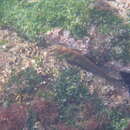fr
noms dans le fil d’Ariane


Ophioblennius steindachneri és una espècie de peix de la família dels blènnids i de l'ordre dels perciformes.
És un peix marí de clima tropical i associat als esculls de corall que viu entre 0-18 m de fondària.[4][7]
Es troba des del nord del Golf de Califòrnia[8] fins al Perú,[9] incloent-hi les Illes Galápagos.[4][10][11][12][13] [14][15]
Ophioblennius steindachneri és una espècie de peix de la família dels blènnids i de l'ordre dels perciformes.
Ophioblennius steindachneri, the large-banded blenny or the Panamic fanged blenny, is a species of combtooth blenny found in coral reefs in the eastern Pacific ocean. This species reaches a length of 18 centimetres (7.1 in) SL.[2]
The large-banded blenny exhibits dark coloration as a juvenile, but develops brownish to olive coloration with lighter markings, as well as a dark spot behind the eye and several broad bands from the head and fading behind the pectoral fins.[3]
Ophioblennius steidachneri is found in the eastern Pacific from the Gulf of California to Peru.[2] Its range encompasses the Revillagigedo Islands, Cocos Island, Malpelo Island and the Galápagos Islands.[1]
The adults of Ophioblennius steidachneri are mainly found in the surge zone of exposed rocky headlands which have steep slopes where they wedge themselves into crevices near the shore in shallow water. They are territorial and will dart out of their hiding place to defend their territory. They feed during the day when they graze on algae and prey on sessile invertebrates by using the incisor teeth, which are similar in shape to combs, to scrape food off the rock. Like all blennies they are oviparous, laying demersal eggs which are adhered to the substrate by a filamentous, adhesive pad or pedestal and their larvae are planktonic which are frequently recorded from shallow waters near the coast.[2]
The specific name honours the Austrian ichthyologist Franz Steindachner (1834-1919) who reported this species as Blennophis webbii in 1879.[4]
{{cite web}}: Missing or empty |title= (help) Ophioblennius steindachneri, the large-banded blenny or the Panamic fanged blenny, is a species of combtooth blenny found in coral reefs in the eastern Pacific ocean. This species reaches a length of 18 centimetres (7.1 in) SL.
Ophioblennius steindachneri es una especie de pez de la familia Blenniidae en el orden de los Perciformes.
• Los machos pueden llegar alcanzar los 18 cm de longitud total.[2][3]
Es ovíparo.
Es un pez de mar y de clima tropical y asociado a los arrecifes de coral que vive entre 0-18 m de profundidad.
Se encuentra desde el norte del Golfo de California hasta el Perú incluyendo las Islas Galápagos.
Ophioblennius steindachneri es una especie de pez de la familia Blenniidae en el orden de los Perciformes.
Ophioblennius steindachneri Ophioblennius generoko animalia da. Arrainen barruko Actinopterygii klasean sailkatzen da, Blenniidae familian.
Ophioblennius steindachneri Ophioblennius generoko animalia da. Arrainen barruko Actinopterygii klasean sailkatzen da, Blenniidae familian.
Ophioblennius steindachneri is een straalvinnige vissensoort uit de familie van naakte slijmvissen (Blenniidae).[2] De wetenschappelijke naam van de soort is voor het eerst geldig gepubliceerd in 1898 door Jordan & Evermann.
De soort staat op de Rode Lijst van de IUCN als niet bedreigd, beoordelingsjaar 2007. De omvang van de populatie is volgens de IUCN stabiel.[1]
Bronnen, noten en/of referenties